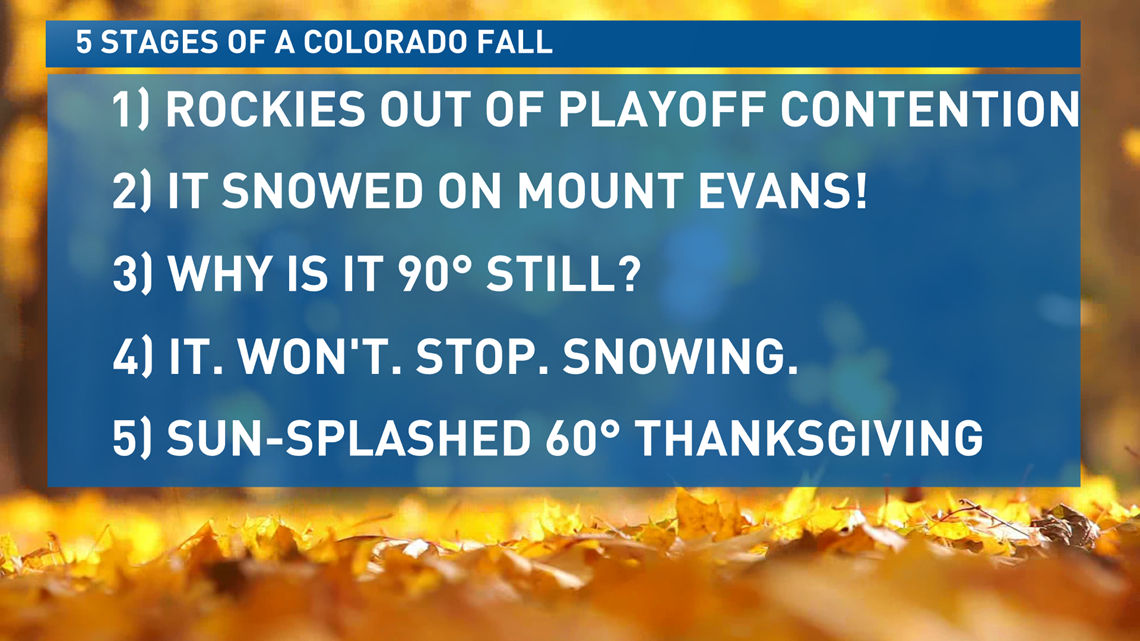DENVER — If you're new to Colorado, then this is probably for you. Even if you're not from here, we've got a feeling you're going to learn something from this.
We all know that Colorado weather is wacky, and we're prone to getting some, shall we say, unusual weather, especially during the winter.
So with that in mind, here's a look at the top five stats that show how unique Colorado winters truly are.
No. 5: Don't plant your gardens until Mother's Day (or maybe even a bit later)
Here's an early hint about Colorado winter weather: Our harshest "winter" conditions often take place during the spring months.
While it's typically colder, on average, in December and January, we're prone to harsh late season cold snaps.
Denver's last freeze, on average, takes place on May 8. We've seen snow as late as early June in Denver, and late May or early June snow is fairly common in the high country.
So in other words, don't plant that garden until Memorial Day. And even then, you're not 100% safe!
No. 4: It's not nearly as cold as you think it is
Yes, it gets cold in Denver. Yes, it can drop as low as -20 degrees in the winter (Denver's coldest temperature on record was a -29 degrees reading on Jan. 9, 1875).
But it's not as cold as our snow-laden license plates might make you think it is.
Thanks to warm, downsloping winds from the west, Denver regularly gets into the 60s and even into the 70s during the heart of winter.
So don't be surprised if you're wearing short sleeves – in the middle of January.
No. 3: Denver gets a lot of snow, but it doesn't usually stick around
Denver gets about 57 inches worth of snowfall each year, a bit more than double that of New York City (25 inches of annual snowfall), for example.
But back to the previous number, it often doesn't stick around all that long. While it might be snowy and cold one day, our prevailing winds come from the west. Those winds are warming winds for us, so temperatures often spike right back up into the 50s or 60s just hours after a snowfall.
Unlike the East Coast or Midwest, that snow usually won't turn black or brown and linger way past its expiration date. Snow usually melts quickly here, and it helps make our winters a lot more tolerable than they might seem.
No. 2: Winter usually comes early in Colorado
You can easily go from 90 degrees to snow in just a day or two around here. Fall is less of a soft transition and more of a bull-in-a-china-shop type of arrival.
Strong, crashing cold fronts can drop temperatures from the 80s or even 90s down below freezing in just a matter of hours. It's part of life at altitude, and it often also makes for quite the dramatic entrance to fall.
Here's our tongue-in-cheek assessment of the five steps of a Colorado fall:


No. 1: Colorado's snowiest month of the year is...
... March. No, it's not January. Or February. Or December. It's March, with April closely behind in the No. 2 spot.
As we're trying to drill home here, spring is almost the real winter around here. Winter itself is long – it can snow as early as the start of September to late May – but it's filled with plenty of 60 or 70 degree days in between.
Because of that, snow doesn't stick around too long when it does fall. While our winters may be long and eventful, they aren't nearly as rough as they might look, especially if you're coming from the East Coast or the Midwest.
SUGGESTED VIDEOS: Snow in Colorado
MORE WAYS TO GET 9NEWS
Subscribe to our daily 9NEWSLETTER
Download the 9NEWS APP
iTunes: http://on9news.tv/itunes
Google Play: http://on9news.tv/1lWnC5n
HOW TO ADD THE 9NEWS APP TO YOUR STREAMING DEVICE
ROKU: add the channel from the ROKU store or by searching for KUSA.
For both Apple TV and Fire TV, search for "9news" to find the free app to add to your account. Another option for Fire TV is to have the app delivered directly to your Fire TV through Amazon.

